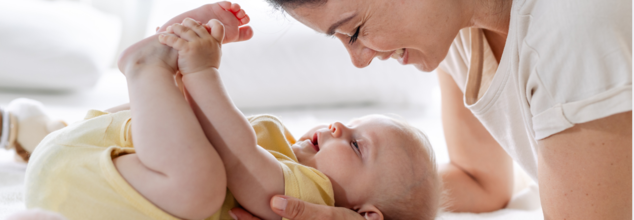
Baby’s First Year: A Guide To Infant Developmental Milestones
Baby’s First Year: Month-By-Month Guide To Infant Developmental Milestones
The first year is the most phenomenally transformational period of a baby's life. Your little one evolves from an absolutely helpless newborn into a lively toddler within 12 short months, with significant milestones achieved during this process. From the first coo to the first step, this period is all joy and curiosity for new parents. While developmental milestones give a guide to this development, it's important to note that every baby is unique and that the timelines for these milestones vary.
The first year of any baby's life is a rollercoaster of emotions, growing, and learning. While guides are helpful, every baby is unique, and things develop on their timeline. Celebrate each small thing, knowing that these will be the building blocks that form your child's life.
Developmental Milestones
Developmental milestones are the key behaviors and physical skills children achieve as they grow. These milestones fall into four categories: physical, cognitive, social/emotional, and language/communication.
- Physical milestones: Rolling over, sitting, crawling, standing, and eventually walking.
- Cognitive milestones: Tracks objects, solves simple problems, explores environment.
- Social/emotional milestones: Smiles, laughs, exhibits stranger or separation anxiety.
- Language milestones: Babbling, cooing, and saying first words.
Each baby grows in a special way, so the timeline of development has small differences from one to another. Knowledge of what a baby does each month allows parents to support their little one with confident and caring gestures.
Month 1: The Newborn Phase
At birth, babies are mainly concerned with adapting to life outside the womb. During the first month, your baby's development is around basic reflexes and sensory experiences:
Reflexes: Flinching at loud noises and shutting their eyes at bright lights.
Sensory Development: Focusing on objects within 12 inches and turning toward familiar sounds, especially their parents' voices.
Hand Movements: Bring hands and fists toward their mouth but not in much control. Though these actions seem rudimentary, they are foundations for more advanced skills.
Month 2: The First Social Smiles
By two months of age, babies start exhibiting more social interaction. Parents like to see the first smile from their baby, signifying increasing interaction:
Social Skills: Smiling and cooing, responding to familiar faces and voices.
Motor Development: Trying to hold his or her head up, and pushing up with his or her arms when in tummy time.
Visual Tracking: Moving the eyes to follow movement, coordination still developing.
All these small steps mean transition from newborn reflexes into intentional actions.
3-4 months: Strengthening and Interacting
By the third and fourth months, your baby becomes more sensitive to their environment, engaging with objects and people:
Head Control: The child is able to hold its head steady and upright for more extended periods.
Grasping: The baby is able to hold onto toys, such as rattles, and shake them.
Expression: The baby mimics parental expressions and coos more often.
Rolling Over: Some babies will begin rolling from tummy to back.
This is also when babies begin to recognize emotions in voices, deepening their bond with caregivers.
Months 5-6: Exploring the World
By mid-year, your baby’s strength and coordination improve significantly. You’ll notice more deliberate movements and an eagerness to explore:
Sitting Up: Briefly sitting without support and pushing themselves up during tummy time.
Object Play: Transfer of objects from one hand to another and oral exploration. Language Development: Babbling with consonant and vowel sounds like "ma-ma" or "da-da."
Emotional Expression: Laughing, squealing, or whining based on feelings.
At this age, solid foods can also be introduced since babies indicate readiness through interest in meals and greater control over their hands.
Months 7-8: On the Move
The last half of the year increases mobility and curiosity. For months seven and eight, babies will begin to develop some more complex motor skills such as:
Sitting Independently: Sit for long periods without support.
Crawling Pre-Cursors: Rocking on hands and knees, ready to crawl.
Standing: Pull up to a standing position by holding onto furniture.
Hand Skills: Using the "raking grasp" to reach for objects and moving them from one hand to another.
Emotionally, babies begin to recognize tones of voice and exhibit stranger anxiety, a normal phase in their socialization.
Months 9-10: Crawling and Cruising
By nine months, your baby is likely to be on the move, learning the thrill of getting around on his or her own:
Crawling: Most babies start crawling, but some skip this stage and cruise right to walking.
Pincer Grip: Picking up small objects with their thumb and forefinger.
Cruising: Walking while holding onto furniture, a precursor to walking.
Language Skills: Babbling strings of consonants, with occasional "words" like "mama."
Expect much exploration and experimentation, as babies like to explore objects by banging, throwing, or dropping them.
Months 11-12: The First Steps
As the first year comes to a close, your baby becomes an emerging toddler. During months 11 and 12, they often take their first independent steps:
Walking: Some babies start walking on their own, while others cruise.
Communication: Using simple words such as "hi" or "bye" and understanding simple commands.
Imitation: Imitation is shown through actions such as pretending to talk on the phone.
Problem-solving: Placing objects in and out of containers is one of the signs of cognitive development.
By the end of the first year, the baby's growth shows an incredible mixture of physical, emotional, and social milestones.
Ways You Can Support Your Baby's Development
Parents play a critical role in fostering growth. Provide a safe and stimulating environment with toys and activities that encourage exploration. Regular check-ups with a pediatrician ensure milestones are met, and any concerns are addressed promptly.
When Should You Consult a Paediatrician?
If you feel that your baby is not advancing in milestones or is delayed significantly, trust that instinct and visit a doctor. Early intervention can mean all the difference, and as a parent, you are always right.
© 2024 Bennett, Coleman & Company Limited

